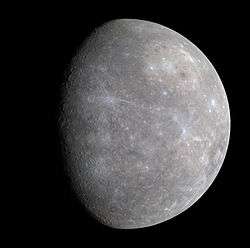Sobkou Planitia
| Planet | Mercury |
|---|---|
| Coordinates | 39°54′N 129°54′W / 39.9°N 129.9°WCoordinates: 39°54′N 129°54′W / 39.9°N 129.9°W |
| Eponym | Egyptian messenger god Sobkou |
Sobkou Planitia is a large basin on Mercury. It is named after an Egyptian crocodile (whose name is more usually transliterated Sobek) god among a diverse range of godly duties, he was associated by the Egyptians with the planet known today as Mercury.
History
Sobkou Planitia was discovered after Sobkou, the basin, was recognized as a Pre-Tolstojan basin on images from Mariner 10.[1]
Geology
The most prominent features within the plain itself are a pair of craters, similar in size to one another, known as Brontë (Mercurian crater) and Degas (crater). Brontë is the older of the two craters, and the impact the formed Degas has overlapped the edges of that older crater and spread a spray of rays across the southern regions of Sobkou Planitia and beyond.[2]
According to Peter Grego's book, "Venus and Mercury and how to observe them", Sobkou Planitia is free of scarps, ridges, fractures and valleys. Its southeastern edge is bordered by the scarp Heemskerck Rupes (26N, 125W) which is about 300km long which along part of the line of a very broad, bright swathe which is 1,000 km long and terminating just to the east of Chong Ch'ol (45N, 116W).[3]
References
- ↑ Rothery, David (2014). Planet Mercury: From Pale Pink Dot to Dynamic World. Springer. p. 120. ISBN 9783319121178.
- ↑ http://www.glyphweb.com/esky/surface/sobkouplanitia.html
- ↑ Grego, Peter (2007). Venus and Mercury, and How to Observe Them. Springer Science & Business Media. p. 43. ISBN 9780387742861.
